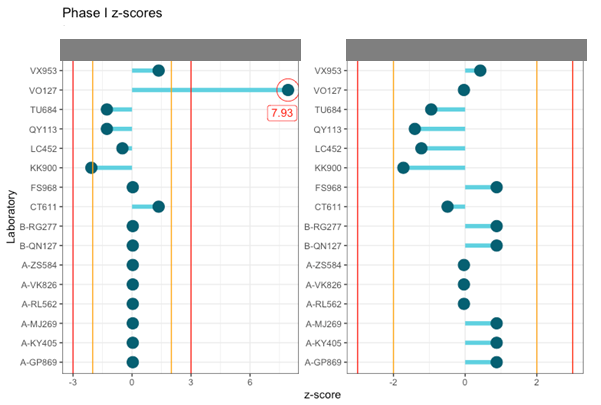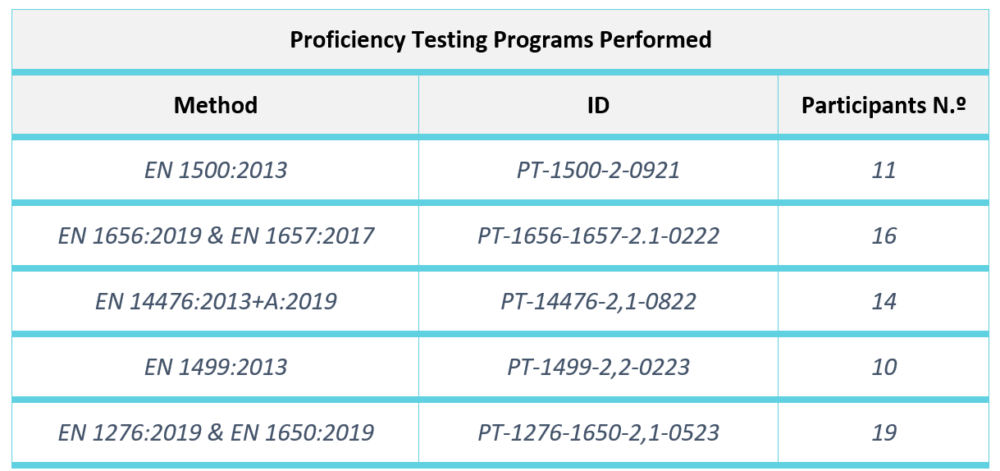Before we go into depth we should know how to detect if our result is outside the established optimal classification.
If you participate in our inter-comparison testing you should know that we score with the z-score value.
We use the algorithm A for the assigned values, described in Appendix C of ISO 13528 as stated in our quality system based on ISO/IEC 17043.
- z-score > 3 = UNACCEPTABLE VALUE
- 2 ≤ z-score ≤ 3 = ALARM SIGNAL VALUE
- 0 ≤ z-score < 2 = ACCEPTABLE VALUE
Below, we show graphically how we facilitate the results of our programs:

The values between the orange and red band are values where the z-score is between 2 and 3, therefore, the value obtained is an ALARM SIGNAL for the participating laboratory.
The values that exceed the red band are values whose z-score has exceeded the value of 3 and, therefore, the value obtained is UNACCEPTABLE.
How do we deal with this situation?
At SHAPYPRO we offer our participants support during CAUSE ANALYSIS, which according to ISO/IEC 17025 must be carried out and documented, and which consists of an analysis of CAUSES, CONSEQUENCES and SCOPE.
The root cause analysis is the most important and sometimes the most difficult part. Often the root cause is not obvious and therefore a careful analysis of all potential causes of the problem is required. Potential causes could include the test requirements, processes, computerised systems, methods and procedures, personnel skills and training, equipment, consumables, etc.
Therefore, here are some TIPS for conducting a good root cause analysis.
First of all, is to establish a multidisciplinary working group, that brings experience and knowledge in the fields of key impacted processes, quality assurance, technical management, and proficiency testing provider.
Below, we detail how we should address each of the questions we face in a root cause analysis, and what answers we are looking for.
- Causes: The possible causes that originated it, we ask ourselves what happened?
- Consequences: The consequences of the impact on the system, project or process, we ask ourselves what impact does the impact have on our processes?
- Scope: How far do the consequences of the incident affect us, we ask ourselves what processes, people, equipment, etc., have been affected?
If we correctly analyse the causes, we will be able to establish mitigating measures and, above all, maintain control over the affected processes and/or services. By being able to demonstrate our technical competence in accreditation audits.
Classification of deviations in a Ring Trial
Each cause analysis carried out must be formalised in a report, drawn up by the person assigned independent of the origin of the deviation, where the conclusions obtained will be reflected.
Normally, 3 levels of classification are foreseen:
Critical (C): The condition critically affects the technical competence and may affect the quality of the result of the tests developed in the laboratory.
- ACTION: Corrective action must be taken immediately.
Major (M): Evidence or suspicion of problems that could affect technical competence and the result.
- ACTION: Corrective action should be taken within a short period of time.
Minor (m): Isolated deviation that could affect technical competence, provided there is evidence that the test procedure is properly implemented and functioning.
- ACTION: Corrective action should be taken.
Our proficiency testing programs
Since 2021 we have been developing inter-laboratory inter-comparison tests in the field of quantitative suspension tests for the evaluation of biocidal activity for antiseptics and chemical disinfectants in accordance with European standards.

IF YOU WANT TO KNOW MORE, CONTACT US!
We are creating the 2024 agenda, all our 2023 participants will receive the 2024 agenda free of charge, if you are not yet a participant and are interested in receiving it, please write to us;
Do you want to get access to our 2024 agenda? Download it here.


